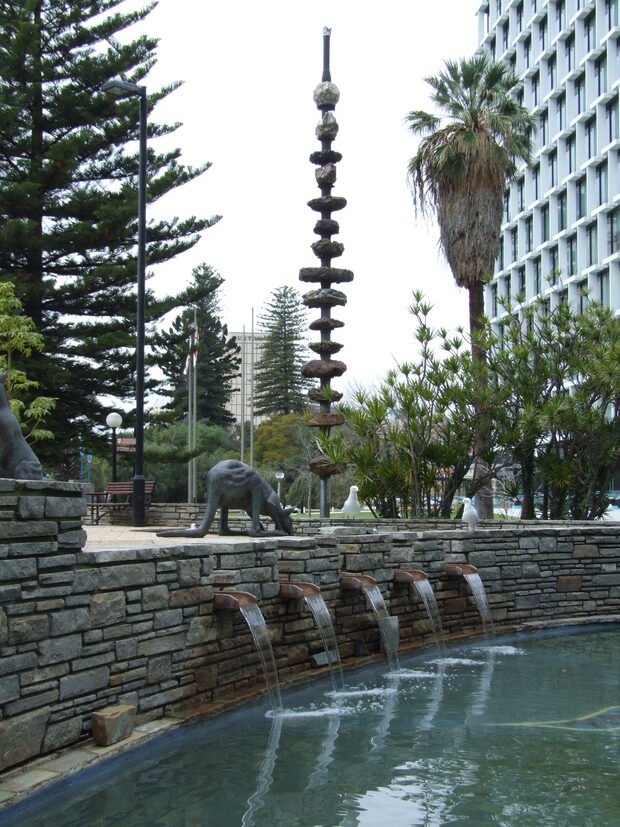'Stepping stones’ is a pamphlet produced by the Geological Survey of Western Australia (GSWA), which accompanies two self-guided geology walking trails in Perth.
Trail 1
Trail 1 of Stepping stones leads you through the city from East Perth to the foot of Kings Park to find a floating granite sphere, heritage gardens, and other geological features. Below are some examples of what you can see along this trail. Trail 1 can also be followed using an app on your smart device. See information on accessing the app below.

This floating stone sphere, sculpted from Western Australian orbicular granite, was designed and manufactured in Perth. Perfectly balanced, the sphere rotates unassisted on a film of water, but with just the touch of a finger, the sphere may be stopped, and then gently pushed in any direction — even by a small child.
The mystique attached to this floating sphere has made it a captivating and wondrous geological attraction in Forrest Place.
The sphere is made of rare orbicular granite, quarried on Boogardie Station near Mount Magnet, 600 kilometres northeast of Perth. Large, closely spaced, light- to dark-grey, egg-shaped orbicules of hornblende and plagioclase feldspar lie in a groundmass of granite. A large vein of quartz and feldspar cuts across the rock. Similar rocks in the region have been dated at 2685 million years. See more.

The ore obelisk (popularly referred to as ‘the rock kebab’) is a memorial to the State’s progress. Erected in July 1971, it celebrated jointly the millionth citizen in the State and the decade-long exploration and mining boom between 1960 and 1970 that transformed the State. The obelisk has elicited a range of reactions. It nestles among trees and lawns in Stirling Gardens, implying that mining and conservation go hand in hand.
Designed by architects Paul Ritter and Ralph Hibble, the 15 metre oil-well drill pipe has 15 different chunks of ore threaded onto it. All are from Western Australia and showcase the wealth and diversity of our mineral treasure — from bauxite to nickel to iron ore (with diamond, gold, lead and copper in between).
The low boundary walls of the adjacent reflection pond are made of Toodyay Quartzite, placed bookleaf style. The rock is an orthoquartzite a (metamorphosed quartz sandstone) and features sparkling pale-green fuchsite (a chrome mica mineral) on its surfaces. The flaggy, banded quartzite easily splits into almost perfectly flat flagstones. A highly decorative local stone, it is used for feature walls (as here) and urban landscaping.

Trail 2
Trail 2 enables you to combine shopping, drinking and eating, and some geology as you stroll along St Georges Terrace in the Perth CBD. You can see façades, pavements, stairways and columns made from many different polished and honed rocks. See some examples of what you can see are listed below.
The location is 12 St Georges Terrace, façade and columns. This unusual rock is called rapakivi granite (and it most likely comes from Finland). It is an igneous rock. The texture is characterized by large round crystals of pinkish brown orthoclase (a feldspar) rimmed with pale-green plagioclase (also a feldspar), with some other minor minerals such as hornblende and biotite. It makes a spectacular rock — appropriate for the address of the Chamber of Minerals and Energy!


Five colourful green elements make up this false marble wall in the foyer of a St Georges Terrace office building. The white marble steps are real and the mosaic flooring contains multicoloured marble mosaic tiles. It is a reminder of the building’s former glory when the entry foyer warranted special treatment by artisans and builders.
Built between 1859 and 1864, Government House is one of the key heritage buildings in Western Australia. It is a two-storey mansion in the Jacobean Revival style, complete with turrets. Stonework around the archway is in Tamala limestone, a commonplace building stone for early Perth, which sets off the façade's Flemish bond brickwork. The Tamala limestone is in blocks, columns and pillars, and includes some simple carved patterns.
Download the Stepping Stones pamphlet
Finding geology in Perth City (app)

The Geological Survey of Western Australia (GSWA) has added a Finding geology tour to the Everythere app to explore some ‘rocky’ locations around Perth using your smart device. As you pass by six key locations in Perth, you’ll get notifications about interesting geological features.
Scan the QR code to download Everythere from the App Store or Google Play Store.
To start exploring on an Apple devices
1. Open the app, select the Tours tab and scroll to Finding geology in Perth City
2. Click on the tour title then the Discover button
3. Begin walking or cycling around Perth, visiting the six sites. As you pass each location coordinate, the digital media will activate on your device
4. Check out the Map tab to see nearby tours and click on the tour icon to download.
To start exploring on an Android phone
1. Open the app and search the tours
2. Tap on the hexagon on Finding Geology in Perth City to download all the media ready for your tour
3. Tap on the photo to see where the interactive tour starts (Introduction, Setting off, Discover)
4. Begin walking or cycling at Site 1, Queens Gardens and follow the tour. As you near each of the location coordinates, the digital media will activate.
Note that the locations will not be visible until you are within range.
So grab your walking shoes or your bicycle (and of course your phone) and head east to Queens Gardens in Hay Street to start your geological fun walk around the city.
Contact
For further information and to provide feedback on the app, contact:
geotourism@dmirs.wa.gov.au
